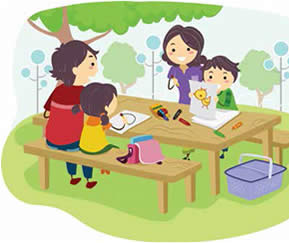There are many researches and debates among educators, policy makers, paediatricians and parents on the benefits and disadvantages of technology over the years. Here are a few of them:
The Pros :
- Makes long-distance communication possible: kids are able to talk to friends and families who are far away.
- Teaches cause and effect: entices your child’s curiosity and encourages him to explore from the safety of your home.
- Pushing keys and using the mouse help in fine-tuning your child’s fine-motor skills which enhances their eye-hand coordination.
- Studies done by independent researchers found that the use of technologies could support home learning in:
- Operational learning: parents can teach their kids how to control and use technology, and it is an opportunity for parents to encourage personalised responses by contributing their own input.
- Extending knowledge and understanding of the world: kids can find out about people, places, and the natural world.
- Dispositions to learn: encourages concentration and persistence, helps them to build self-confidence and selfesteem and also increases their competence in using technology.
- The role of technology in everyday life: through observing their parents, your child will learn how technology can help with everyday things such as travel research, ordering goods, sending texts, communicating with people far away, etc.
The Cons :
- In 2010, the American Academy of Pediatrics (AAP) warned that technology may affect pre-schoolers’ developing cognitive and social skills.
- Learning toys may dampen educational potential as most interactive toys are made based on mundane educational tasks. These toys may provide some motivation for learning at first but young kids may get bored and stop learning if they have not mastered the operational aspects of clicking, scrolling or pressing actions.
- Operational problems could be solved by tablet computers but the extensive use of tablet computers does not encourage innovative learning as some apps are simply a copy of their predecessor, i.e. electronic books.
- No stimulation of adult-child conversations: technological interactivity can never replace human interaction as current technology cannot replace the human element of interaction between parent and child.
- Increases aggressive responses from playing violent video games.
- Potentially disrupts sleep: children needs at least 12 hours of sleep per day for them to grow healthily.
- Encourages sedentary lifestyle: as mentally stimulating as they are, technological devices do not promote physical stimulation as much as physical activity. Kids need to move about as it helps them to build strong muscles and learn what their bodies can do. When sedentary lifestyle becomes a habit since young, kids will be faced with the increased risk of obesity.
- Leads to technology addiction.
Striking a balance

As we can see, technology has its pros and cons on a child’s development. As it is impossible to completely
restrict the use of technology, it is the responsibility of the parents to strike a balance. Here are a few tips:
- Switch off the TV and put away your phones during meal times and encourage conversation among one another.
- Remove any gadgets, especially TV and laptops from bedrooms.
- Get outdoors and move your body in sports like badminton, jogging, or even gardening (young kids enjoy playing with dirt and mud).
- Keep all gadgets 30mins before bedtime, read or sing a lullaby to them.
- Schedule about 1 hour of technology-free time every day.
- Introduce traditional games back into your child’s playtime such as hide and seek, Scrabble, chess, congkak etc.
- Get back to nature. Bring the family for fishing or hiking.
- Try out new hobbies such as reading, painting, cooking, clay modelling etc.
- Be actively involved with your child when they are using interactive technologies to learn.
- Join a volunteer group – this encourages social interactions and they’re helping others.
Quoting from Dr Marjorie Hogan, one of the paediatricians who helped draft the AAP screen time guidelines for kids, “media consumption can be seen in the same way as food consumption”. It is all about moderation and choosing the right content. Don’t be afraid to use technology as it is undeniable that there are many new gadgets and applications which are useful for your kids. Just be mindful and know when it is the right time for a time-out.
An educational collaboration with Malaysian Psychiatric Association.
An educational contribution by Malaysian Paediatric Association.







Comments